使用TensorFlow v2.0构建多层感知器
使用TensorFlow v2.0构建一个两层隐藏层完全连接的神经网络(多层感知器)。
这个例子使用低级方法来更好地理解构建神经网络和训练过程背后的所有机制。
神经网络概述

MNIST 数据集概述
此示例使用手写数字的MNIST数据集。该数据集包含60,000个用于训练的示例和10,000个用于测试的示例。这些数字已经过尺寸标准化并位于图像中心,图像是固定大小(28x28像素),值为0到255。
在此示例中,每个图像将转换为float32并归一化为[0,1],并展平为784个特征的一维数组(28 * 28)
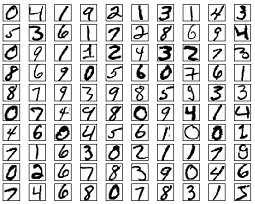
更多信息请查看链接: http://yann.lecun.com/exdb/mnist/
from __future__ import absolute_import, division, print_function
import tensorflow as tf
import numpy as np
# MNIST 数据集参数
num_classes = 10 # 所有类别(数字 0-9)
num_features = 784 # 数据特征数目 (图像形状: 28*28)
# 训练参数
learning_rate = 0.001
training_steps = 3000
batch_size = 256
display_step = 100
# 网络参数
n_hidden_1 = 128 # 第一层隐含层神经元的数目
n_hidden_2 = 256 # 第二层隐含层神经元的数目
# 准备MNIST数据
from tensorflow.keras.datasets import mnist
(x_train, y_train), (x_test, y_test) = mnist.load_data()
# 转化为float32
x_train, x_test = np.array(x_train, np.float32), np.array(x_test, np.float32)
# 将每张图像展平为具有784个特征的一维向量(28 * 28)
x_train, x_test = x_train.reshape([-1, num_features]), x_test.reshape([-1, num_features])
# 将图像值从[0,255]归一化到[0,1]
x_train, x_test = x_train / 255., x_test / 255.
# 使用tf.data API对数据进行随机排序和批处理
train_data = tf.data.Dataset.from_tensor_slices((x_train, y_train))
train_data = train_data.repeat().shuffle(5000).batch(batch_size).prefetch(1)
# 存储层的权重和偏置
# 随机值生成器初始化权重
random_normal = tf.initializers.RandomNormal()
weights = {
'h1': tf.Variable(random_normal([num_features, n_hidden_1])),
'h2': tf.Variable(random_normal([n_hidden_1, n_hidden_2])),
'out': tf.Variable(random_normal([n_hidden_2, num_classes]))
}
biases = {
'b1': tf.Variable(tf.zeros([n_hidden_1])),
'b2': tf.Variable(tf.zeros([n_hidden_2])),
'out': tf.Variable(tf.zeros([num_classes]))
}
# 创建模型
def neural_net(x):
# Hidden fully connected layer with 128 neurons.
# 具有128个神经元的隐含完全连接层
layer_1 = tf.add(tf.matmul(x, weights['h1']), biases['b1'])
# Apply sigmoid to layer_1 output for non-linearity.
# 将sigmoid用于layer_1输出以获得非线性
layer_1 = tf.nn.sigmoid(layer_1)
# 具有128个神经元的隐含完全连接层
layer_2 = tf.add(tf.matmul(layer_1, weights['h2']), biases['b2'])
# 将sigmoid用于layer_2输出以获得非线性
layer_2 = tf.nn.sigmoid(layer_2)
# 输出完全连接层,每一个神经元代表一个类别
out_layer = tf.matmul(layer_2, weights['out']) biases['out']
# 应用softmax将输出标准化为概率分布
return tf.nn.softmax(out_layer)
# 交叉熵损失函数
def cross_entropy(y_pred, y_true):
# 将标签编码为独热向量
y_true = tf.one_hot(y_true, depth=num_classes)
# 将预测值限制在一个范围之内以避免log(0)错误
y_pred = tf.clip_by_value(y_pred, 1e-9, 1.)
# 计算交叉熵
return tf.reduce_mean(-tf.reduce_sum(y_true * tf.math.log(y_pred)))
# 准确率评估
def accuracy(y_pred, y_true):
# 预测类是预测向量中最高分的索引(即argmax)
correct_prediction = tf.equal(tf.argmax(y_pred, 1), tf.cast(y_true, tf.int64))
return tf.reduce_mean(tf.cast(correct_prediction, tf.float32), axis=-1)
# 随机梯度下降优化器
optimizer = tf.optimizers.SGD(learning_rate)
# 优化过程
def run_optimization(x, y):
# 将计算封装在GradientTape中以实现自动微分
with tf.GradientTape() as g:
pred = neural_net(x)
loss = cross_entropy(pred, y)
# 要更新的变量,即可训练的变量
trainable_variables = weights.values() biases.values()
# 计算梯度
gradients = g.gradient(loss, trainable_variables)
# 按gradients更新 W 和 b
optimizer.apply_gradients(zip(gradients, trainable_variables))
# 针对给定步骤数进行训练
for step, (batch_x, batch_y) in enumerate(train_data.take(training_steps), 1):
# 运行优化以更新W和b值
run_optimization(batch_x, batch_y)
if step % display_step == 0:
pred = neural_net(batch_x)
loss = cross_entropy(pred, batch_y)
acc = accuracy(pred, batch_y)
print("step: %i, loss: %f, accuracy: %f" % (step, loss, acc))
output:
step: 100, loss: 567.292969, accuracy: 0.136719
step: 200, loss: 398.614929, accuracy: 0.562500
step: 300, loss: 226.743774, accuracy: 0.753906
step: 400, loss: 193.384521, accuracy: 0.777344
step: 500, loss: 138.649963, accuracy: 0.886719
step: 600, loss: 109.713669, accuracy: 0.898438
step: 700, loss: 90.397217, accuracy: 0.906250
step: 800, loss: 104.545380, accuracy: 0.894531
step: 900, loss: 94.204697, accuracy: 0.890625
step: 1000, loss: 81.660645, accuracy: 0.906250
step: 1100, loss: 81.237137, accuracy: 0.902344
step: 1200, loss: 65.776703, accuracy: 0.925781
step: 1300, loss: 94.195862, accuracy: 0.910156
step: 1400, loss: 79.425507, accuracy: 0.917969
step: 1500, loss: 93.508163, accuracy: 0.914062
step: 1600, loss: 88.912506, accuracy: 0.917969
step: 1700, loss: 79.033607, accuracy: 0.929688
step: 1800, loss: 65.788315, accuracy: 0.898438
step: 1900, loss: 73.462387, accuracy: 0.937500
step: 2000, loss: 59.309540, accuracy: 0.917969
step: 2100, loss: 67.014008, accuracy: 0.917969
step: 2200, loss: 48.297115, accuracy: 0.949219
step: 2300, loss: 64.523148, accuracy: 0.910156
step: 2400, loss: 72.989517, accuracy: 0.925781
step: 2500, loss: 57.588585, accuracy: 0.929688
step: 2600, loss: 44.957100, accuracy: 0.960938
step: 2700, loss: 59.788242, accuracy: 0.937500
step: 2800, loss: 63.581337, accuracy: 0.937500
step: 2900, loss: 53.471252, accuracy: 0.941406
step: 3000, loss: 43.869728, accuracy: 0.949219
# 在验证集上测试模型
pred = neural_net(x_test)
print("Test Accuracy: %f" % accuracy(pred, y_test))
# 可视化预测
import matplotlib.pyplot as plt
# 从验证集中预测5张图像
n_images = 5
test_images = x_test[:n_images]
predictions = neural_net(test_images)
# 显示图片和模型预测结果
for i in range(n_images):
plt.imshow(np.reshape(test_images[i], [28, 28]), cmap='gray')
plt.show()
print("Model prediction: %i" % np.argmax(predictions.numpy()[i]))
output:
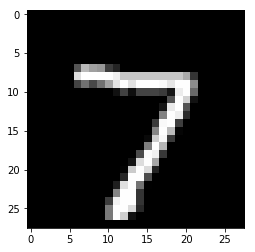
Model prediction: 7
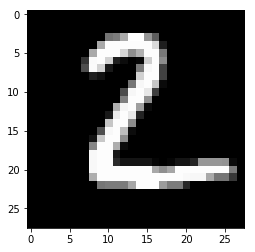
Model prediction:2
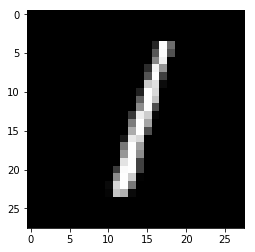
Model prediction: 1
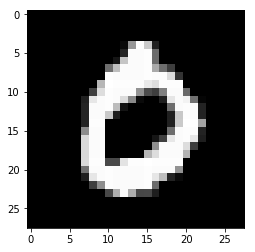
Model prediction: 0
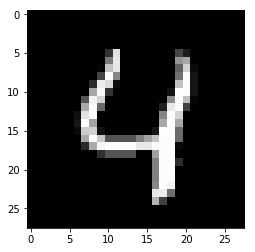
Model prediction: 4
欢迎关注磐创博客资源汇总站:
http://docs.panchuang.net/
欢迎关注PyTorch官方中文教程站:
http://pytorch.panchuang.net/
使用TensorFlow v2.0构建多层感知器的更多相关文章
- 使用TensorFlow v2.0构建卷积神经网络
使用TensorFlow v2.0构建卷积神经网络. 这个例子使用低级方法来更好地理解构建卷积神经网络和训练过程背后的所有机制. CNN 概述 MNIST 数据集概述 此示例使用手写数字的MNIST数 ...
- TensorFlow—多层感知器—MNIST手写数字识别
1 import tensorflow as tf import tensorflow.examples.tutorials.mnist.input_data as input_data import ...
- tensorflow学习笔记——自编码器及多层感知器
1,自编码器简介 传统机器学习任务很大程度上依赖于好的特征工程,比如对数值型,日期时间型,种类型等特征的提取.特征工程往往是非常耗时耗力的,在图像,语音和视频中提取到有效的特征就更难了,工程师必须在这 ...
- TFboy养成记 多层感知器 MLP
内容总结与莫烦的视频. 这里多层感知器代码写的是一个简单的三层神经网络,输入层,隐藏层,输出层.代码的目的是你和一个二次曲线.同时,为了保证数据的自然,添加了mean为0,steddv为0.05的噪声 ...
- 【TensorFlow-windows】(三) 多层感知器进行手写数字识别(mnist)
主要内容: 1.基于多层感知器的mnist手写数字识别(代码注释) 2.该实现中的函数总结 平台: 1.windows 10 64位 2.Anaconda3-4.2.0-Windows-x86_64. ...
- "多层感知器"--MLP神经网络算法
提到人工智能(Artificial Intelligence,AI),大家都不会陌生,在现今行业领起风潮,各行各业无不趋之若鹜,作为技术使用者,到底什么是AI,我们要有自己的理解. 目前,在人工智能中 ...
- TensorFlow v2.0实现Word2Vec算法
使用TensorFlow v2.0实现Word2Vec算法计算单词的向量表示,这个例子是使用一小部分维基百科文章来训练的. 更多信息请查看论文: Mikolov, Tomas et al. " ...
- 4.2tensorflow多层感知器MLP识别手写数字最易懂实例代码
自己开发了一个股票智能分析软件,功能很强大,需要的点击下面的链接获取: https://www.cnblogs.com/bclshuai/p/11380657.html 1.1 多层感知器MLP(m ...
- Spark Multilayer perceptron classifier (MLPC)多层感知器分类器
多层感知器分类器(MLPC)是基于前馈人工神经网络(ANN)的分类器. MLPC由多个节点层组成. 每个层完全连接到网络中的下一层. 输入层中的节点表示输入数据. 所有其他节点,通过输入与节点的权重w ...
随机推荐
- 【桌面篇】Archlinux安装kde桌面
ArchLinux安装配置手册[桌面篇] 现在你的U盘可以拔掉了,重启后会发现和刚刚没什么区别,还是命令行的界面,别着急现在就带你安装桌面环境. 连接网络 首先检查一下网络是否连接成功 ping ww ...
- flask 中文乱码
返回的json数据中包含中文,但前端显示乱码,添加了 app.config['JSON_AS_ASCII'] = False仍然没有解决, app.config['JSONIFY_MIMETYPE'] ...
- FPGA小白学习之路(4)PLL中的locked信号解析(转)
ALTPLL中的areset,locked的使用 转自:http://www.360doc.com/content/13/0509/20/9072830_284220258.shtml 今天对PLL中 ...
- HTTP协议 有这篇文章足够了
HTTP 协议详解 HTTP(HyperText Transfer Protocol)超文本传输协议.其最初的设计目的是为了提供一种发布和接收HTML页面的方法. HTTP是一个客户端(用户)和服务端 ...
- 实用的Python(3)超简单!基于Python搭建个人“云盘”
1 简介 当我们想要从本地向云服务器上传文件时,比较常用的有pscp等工具,但避免不了每次上传都要写若干重复的代码,而笔者最近发现的一个基于Python的工具updog,可以帮助我们在服务器上搭建类似 ...
- 一个基于Bootstrap实现的HMTL可视化编辑工具
疫情禁足在家,用原生的JS实现了一个HTML可视化编辑工具,页面布局基于Bootstrap.大约一个月时间,打通主要技术关卡,实现了第一版: 可以拖放编辑,实现了几乎所有的bootstrap预定义 ...
- 什么是Activiti
什么是Activiti Activiti属于工作流引擎的一个开源实现.Activiti由Tom Bayen发起.在2010年5月发布了第一个版本.命名也很有意思的采取了Activities(活动)的化 ...
- js轮询及踩过的坑
背景 下午四点,天气晴朗,阳光明媚,等着下班产品:我希望页面上的这个数据实时变化开发:···,可以,用那个叫着WebSocket的东西,再找一个封装好框架,如:mqtt(感觉自己好机智)产品:要开发好 ...
- vue项目npm run dev 报错Uncaught SyntaxError: Unexpected token <
目前代码所处位置是micro分支,该分支是从dev分支直接拉下来进行npm run dev的,而dev分支是可以正常运行的,网上的诸多解释是babel转义时候报错,其实对比可见,两个分支不同的地方应该 ...
- Eureka停更了?试试Zookpper和Consul
在Spring Cloud Netflix中使用Eureak作为注册中心,但是Eureka2.0停止更新,Eureka1.0 进入了维护状态.就像win7一样,同样可以用,但是官方对于新出现的问题并不 ...
